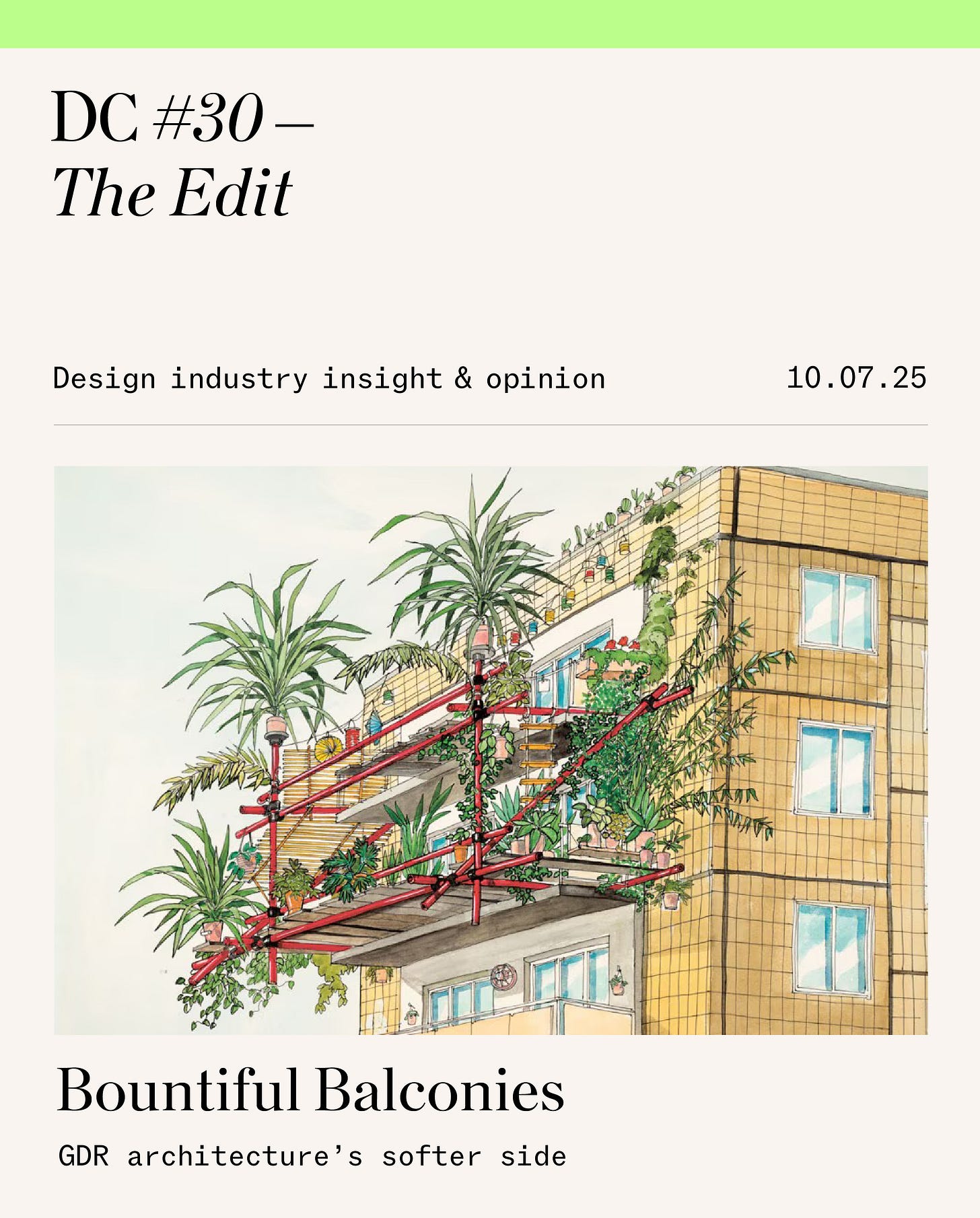Design Considered #30 - The Edit
A relook at East German architecture, good-looking Japanese luggage, and more...
#01 - Opening Thought
The prefabricated concrete housing blocks—Plattenbau—of the German Democratic Republic (GDR) remain shorthand for the ideological rigidity and architectural uniformity that defined East German urban planning from the 1950s through to the 1980s. Yet, as the above image from East Berlin’s Lutz‑Werner Brandt illustrates, the ideas of the architects of the time weren’t always aligned with what was being built by the communist state.
Works like Brandt’s Balkonträumereien (1983), now on display at Berlin’s Tchoban Foundation in the exhibition "Plans and Dreams – Drawn in the GDR," reveal a moment of ambition and imagination, where architects pushed against state-imposed constraints, albeit, sadly, only on paper.
Drawing on around 140 original works—ranging from fantastical visions to progressive urban proposals—the exhibition captures an overlooked chapter in architectural thinking. As curator Wolfgang Kil says in a recent FAZ article, GDR architects rejected the idea of buildings as sterile "living machines," instead emphasising modesty, flexibility, and practicality—qualities that feel particularly relevant amid today’s housing crises.
#02 - For Your Consideration
Nomad art and design fair co-founder Giorgio Pace’s residential property in coastal Molise, Italy, comes to life in a sumptuously shot feature in the Financial Times. A tastefully decorated home in Termoli’s old quarter, the artist’s residence is part of Pace’s vision to transform this tranquil Adriatic town into an influential hub for the creative world. Pace has also enlisted Japanese architect Kengo Kuma to design the forthcoming Giorgio Pace Foundation, a cultural space set to open in Termoli next year.
Indonesia’s Ronald Akili is another discerning entrepreneur who has attracted a cultured crowd to the projects gathered under his Potato Head Family hospitality brand. In this Travel+Leisure video interview, Akili inspiringly unpacks the philosophy—smart, social, and sustainable —that has sensitively shaped the Balinese spaces his team crafts and grows.
A further splash of sunshine can be found at the photography exhibition Sunset Ketchup, by Romain Laprade, in Antwerp’s great FIFTY ONE TOO Gallery, which is wrapping up this week. The works offer a languid vignette of aesthetically striking spots at dusk, from Marrakech tennis courts to Mexican coastal towns, captured through the French photographer’s lens.
A Practice for Everyday Life breathes originality and sophistication into brand activations, deftly balancing client needs with their distinct graphic sensibility. For Vitra’s exhibition The Shakers: A World in the Making, now on display at the Vitra Design Museum, the studio’s custom sans-serif typography—inspired by historic Shaker objects—and tactile signage unify the religious movement’s stripped-down design sensibility with contemporary clarity across the exhibition’s storytelling elements and book.
Birkenstock continues to get retail right, favouring small-scale, neighbourhood-specific spaces over shiny but soulless high-street shops. For the sandal specialists’ latest outpost in The Hague, the brand collaborated with ADH Design, elegantly blending local cues, such as hues from the Hague School art movement, with Art Deco geometry, expressed beautifully through Fußbett-inspired graphic window panelling.
#03 - Design Selection
Muji's recently reissued hard-shell aluminium luggage pieces make a compelling case to muscle out Rimowa this summer as your new, cheaper and maybe sleeker transit companions. Available now in Europe via the Japanese brand’s higher-end line, Muji Labo, these precisely engineered anodised aluminium suitcases in black and silver were initially released in 2017, designed by Japanese legend Naoto Fukasawa.
Muji is a master of product creation for travel (once you adapt its space-saving clothing compression bags into your packing routine, you'll understand). Its well-made wares are also well-priced, and the costs of these robust yet lightweight pieces (available in small and medium sizes) are much more sensible than similar items from premium luggage purveyors. With dual TSA locks, a zipper-free latch closure, and smooth 360° wheels, these suitcases offer a functional punch in an irresistibly stylish form.






In what can only be an extreme coincidence, I spent yesterday walking through East Berlin remembering how my own Honours project many years ago was influenced by German social housing. Only 4 days prior I had purchased my first pair of Birkenstocks in an ancient shop with foot thick walls in Benevento, Italy. :-)